What Is the Best Wood for Picnic Tables? (With Pictures)
-
Pete Ortiz
- Last updated:

If you’re a big fan of outdoor dining, a picnic table is a must. Mostly crafted from wood, these tables come with benches to seat a large crowd and have an A-frame structure. What’s the right wood type for such a table, though? It all depends on what you’re looking for.
For example, teak is incredibly hard and long-lasting, but it’s also expensive. Cedar, in turn, is more affordable but not very hard. And then you’ve got mahogany, oak, and redwood, to name a few. Each wood type is unique. We’re talking about the weight, workability, resistance, and, of course, price.
The following list includes our top seven picks for a picnic table. Let’s take a closer look to see which one fits you best!
 The 7 Best Types of Wood for Picnic Tables
The 7 Best Types of Wood for Picnic Tables
1. Teak
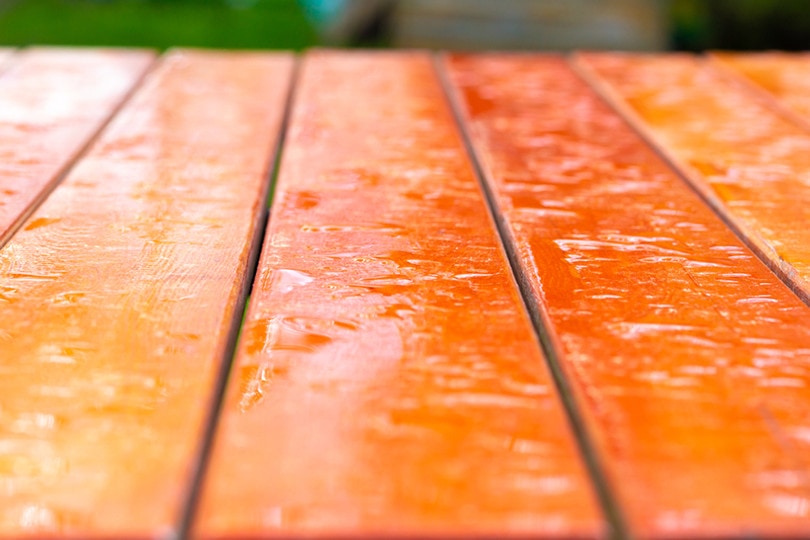
| Wood Type | Hardwood |
| Hardness (Janka Scale) | 2330 lbf |
| Wood Density | 67.4 lb/ft3 |
| Water/Decay/Insect Resistance | Very High |
| Flexibility/Ease of Use | Moderate/High |
| Weight | Moderately Heavy |
| Cost | Very Expensive |
Teak is one of the most expensive woods on the planet. So, if you’re on a tight budget for the picnic table, you might want to skip it. On the other hand, teak’s high price is well-justified by its properties. First, it is incredibly hard, dense, and holds a decent amount of weight. Second, it’s incredibly strong against water, decay, rotting, and pests—thanks to its natural oil.
Unless it’s a portable table, weather resistance is a must. And that’s why teak wood will be a worthy investment, especially in the long run. Along with that, it’s also a moderately flexible material, which means it won’t be hard to work with it. The texture and the color deserve our attention as well: they look great in any environment.
2. Mahogany
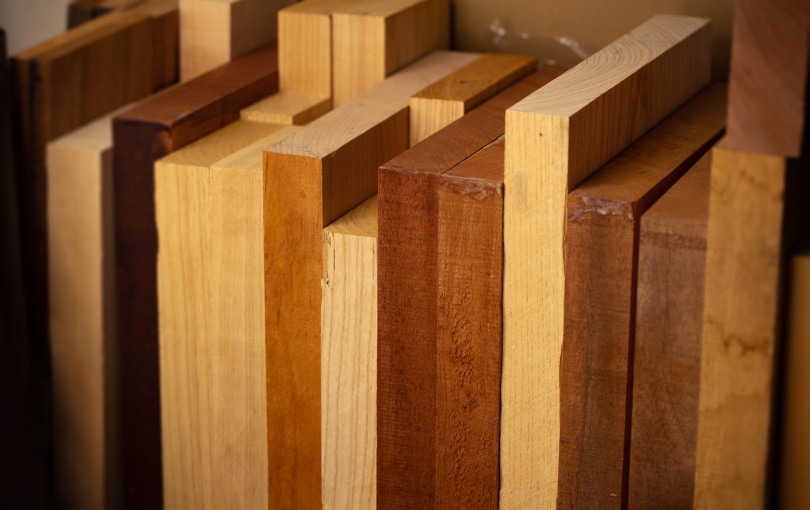
| Wood Type | Hardwood |
| Hardness (Janka Scale) | 900 lbf |
| Wood Density | 56 lb/ft3 |
| Water/Decay/Insect Resistance | High |
| Flexibility/Ease of Use | Very High |
| Weight | Lightweight |
| Cost | Expensive |
Next up, we’ve got mahogany, another premium-quality wood that comes at a steep price. It’s not as expensive as teak, though, but still highly resistant to water, insects, and decay. More importantly, it is extremely easy to work with and lightweight. You’ll be able to craft a picnic table from it even if you don’t have a carpenter’s degree. Plus, lightweight tables are a lot more mobile.
As for the cons, this wood type “sits” significantly lower on the Janka hardness scale (900 vs. 2300 if we compare it to teak). It’s still durable and reliable, of course, yet hot as brick-strong. Finally, the reddish, orange color and the fine grain patterns will give your picnic table a lovely touch.
3. White Oak
| Wood Type | Hardwood |
| Hardness (Janka Scale) | 1,360 lbf |
| Wood Density | 56.2 lb/ft3 |
| Water/Decay/Insect Resistance | High |
| Flexibility/Ease of Use | Moderate/High |
| Weight | Very Heavy |
| Cost | Moderately Expensive |
Oak is an incredibly popular wood material for furniture because it’s the “golden middle” between teak and mahogany on one side and the cheaper alternatives on the other. White oak boasts above-average hardness and density, which automatically means it won’t break or scratch easily. Add high resistance to elements and insects, and you’ll see why it’s a go-to choice for a picnic table.
There is one big downside, though: white oak is very heavy and much harder to move around than any other wood material on the list.
Should You Go With Red Oak Instead?
The most significant advantage of red oak over its white counterpart is the price: it’s more affordable. On top of that, it has a lighter texture, which many people tend to like. Next, dents and scratches are easier to hide on red oak. However, it’s not nearly as hard, and water/decay resistance is average at best.
4. Redwood
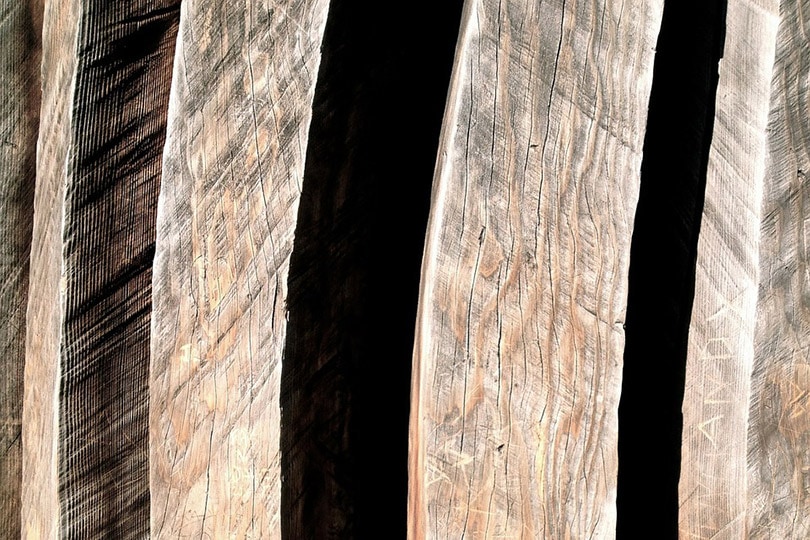
| Wood Type | Softwood |
| Hardness (Janka Scale) | 402 lbf |
| Wood Density | 28 lb/ft3 |
| Water/Decay/Insect Resistance | High |
| Flexibility/Ease of Use | Very High |
| Weight | Extremely Lightweight |
| Cost | Moderately Expensive |
Just like the name suggests, this wood species is red. To add to that, it has “rustic” grain patterns that look marvelous on picnic tables. This is a flexible, extremely lightweight material that comes at a reasonable price. Along with that, redwood’s resistance to humidity and decay is very high. The same is true for resistance to pests. Unfortunately, it isn’t at all hard (402 lbf).
So, if you want your redwood table to last, make sure to apply a layer or two of a reliable, top-quality finish. And see that it’s sealed properly; otherwise, the red pigment might ruin your clothes!
5. Cedar

| Wood Type | Softwood |
| Hardness (Janka Scale) | 900 lbf |
| Wood Density | 25.6 lb/ft3 |
| Water/Decay/Insect Resistance | Very High |
| Flexibility/Ease of Use | Very High |
| Weight | Extremely Lightweight |
| Cost | Relatively Affordable |
For outdoor furniture, cedar is a safe bet. It’s relatively hard and boasts high workability. If you’re an amateur woodworker, cedar will be a blast to work with. And, just like redwood, it’s lightweight and easy to carry around. Cedar isn’t particularly expensive, either, and won’t break your bank.
More good news: it is practically immune to “outside threats” like termites, decay/rot, and high humidity levels. That makes it a near-perfect choice for a picnic table. Next, rain, snow, wind, debris, and other natural elements won’t be a problem because cedar easily withstands all of it. You won’t even have to stain or treat it!
6. Douglas Fir
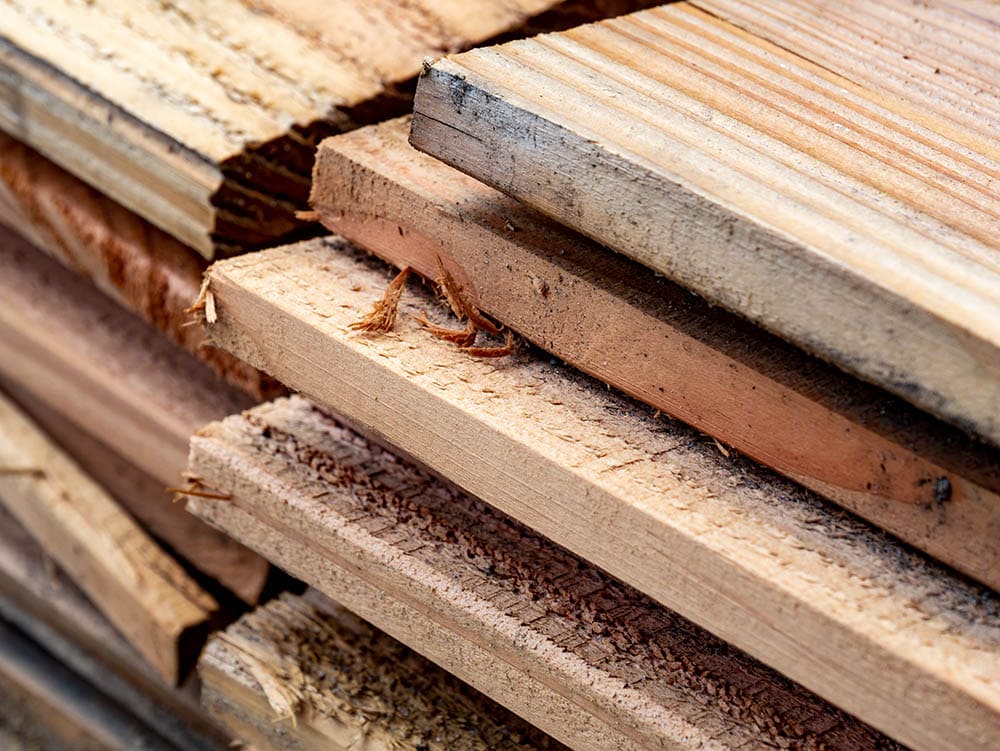
| Wood Type | Softwood |
| Hardness (Janka Scale) | 660 lbf |
| Wood Density | 33.1 lb/ft3 |
| Water/Decay/Insect Resistance | High |
| Flexibility/Ease of Use | Moderate/High |
| Weight | Lightweight |
| Cost | Affordable |
What can you expect from Douglas fir? Is it a decent choice for a picnic table? The answer is yes, it definitely is. This wood is user-friendly, lightweight, and takes minimal effort to cut/shape. Douglas fir is also easy to paint and stain, so you can choose whatever finish you want. It’s quite cheap, too, and that’s what makes it a popular choice for most DIY enthusiasts.
Last, but not least, thanks to high resistance to insects and rot, it’s a great choice for any outdoor project, including, of course, picnic tables. Fir isn’t 100% water-tolerant, however, and scratches easily.
7. Yellow Pine
| Wood Type | Softwood |
| Hardness (Janka Scale) | 870 lbf |
| Wood Density | 34 lb/ft3 |
| Water/Decay/Insect Resistance | High/Low |
| Flexibility/Ease of Use | High |
| Weight | Extremely Lightweight |
| Cost | Very Affordable |
This right here is one of the least expensive options on the market. Woodworkers from all over the globe appreciate its flexibility and seamless, natural texture. With that said, yellow pine is harder than most softwood species and has decent wood density. What about humidity, though? Don’t worry: the southern yellow pine can handle large amounts of water/moisture and won’t rot.
On the downside, it is prone to decay. Furthermore, it is very weak against termites and UV rays. A thick layer of varnish, paint, or lacquer will probably fix that, but it’s still a con.
Hardwood Vs. Softwood: What’s The Difference?
These terms are used to distinguish between woods from broadleaved trees (hardwoods) and conifers (softwoods). Remember: softwoods don’t have pores, while hardwood species lack resin canals. So, which option is best for a picnic table? It depends on what you’re looking for. If durability/longevity is the #1 priority, go with hardwoods. They have an extended lifespan and are sturdier and more reliable.
On top of that, hardwoods are low-maintenance and handle decay, rot, water, and termites effortlessly. The bad news is hardwoods cost more than softwoods, and they’re generally much heavier, which is not good for a mobile picnic table. Does that mean you should pick softwoods instead? Well, not quite. While they are, indeed, more affordable, lightweight, and easier to work with, softwoods have a much shorter lifespan.
How To Pick the Right Wood for a Picnic Table?
It doesn’t really matter whether you’re planning on buying a brand-new picnic table or building one yourself. To get the best “bang for the buck”, it’s very important to know in advance what to look for. What’s the right density for a wood species? Does flexibility play a key role, or not? What about the visual aspect? These are just some of the factors to consider before committing to any type of wood. Here’s a more detailed breakdown:
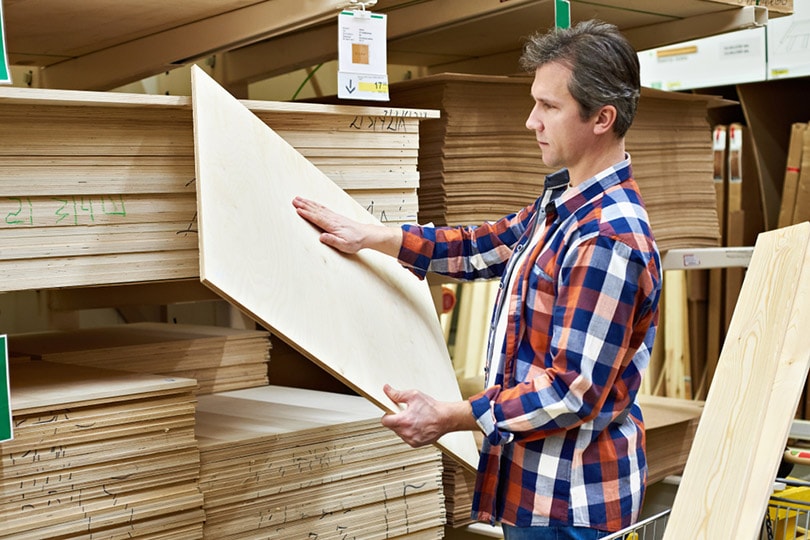
Hardness Plus Density
Even the toughest hardwood types tend to wear and get scratched. To avoid that (or, at least, keep it to a minimum), look for wood materials with an above-average hardness rating. You can check the so-called Janka Scale to figure out exactly how hard the wood species is. For hardwoods, 1000 lbf/pounds-force is a decent place to start (400-600 lbf for softwoods). As for density, 25-30 is just right for softwoods, while hardwoods are 40-50% denser.
Workability/Ease of Use
This only applies if you want to build the table yourself. Softwoods are usually more flexible and easier to work with, but this isn’t a universal rule. Every wood type is unique; so take a moment to learn about the workability of each species. Pay extra attention to flexibility if you don’t have any fancy, expensive equipment to carve out the wood to your liking.
Comfort and Maintenance
You won’t have to worry about comfort if you pick one of the seven wood types from our list because they’re all extremely cozy. You can sit on benches crafted from these wood materials for hours straight. As for maintenance, even the cheapest wood takes minimal effort to keep in proper shape. Some dusting, oil/vinegar cleaning, and keeping it away from direct sunlight will do the trick.
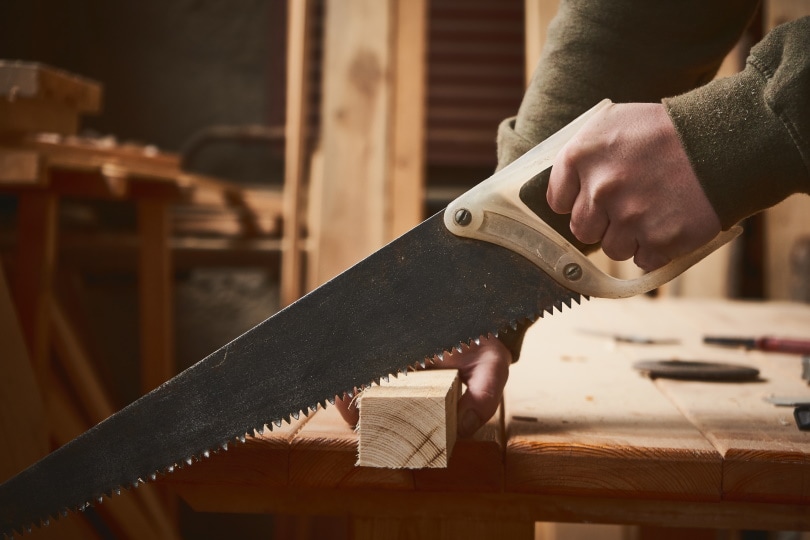
Aesthetics
As a general rule, the more the wood costs, the better it looks. Moreover, expensive wood species don’t rot, scratch, or chip and look as good as new for many years. And if you use premium quality paint or stain, it will not only make the surface look like a million bucks but also serve as an additional “layer of defense” for your picnic table.
Resistance
Humidity is one of the biggest problems for any wood species, along with decay, rust, and mold. Therefore, before picking between the various options on the market, make sure to check the wood’s resistance to all these elements. And don’t forget about the insects! Certain wood types are more resistant to termites than others.
The Price
Teak is very pricey, with mahogany being the close second and oak completing the circle. Now, these are all hardwoods, meaning picnic tables crafted from these woods will last for many years (if not decades) and fight off moisture, rot, and other natural elements. Softwoods cost less (say, pine or fir), but they aren’t as sturdy or robust.
So, the goal here is to find something that’s equally reliable, long-lasting, and reasonably priced. For that, you could go with Douglas fir or cedar.
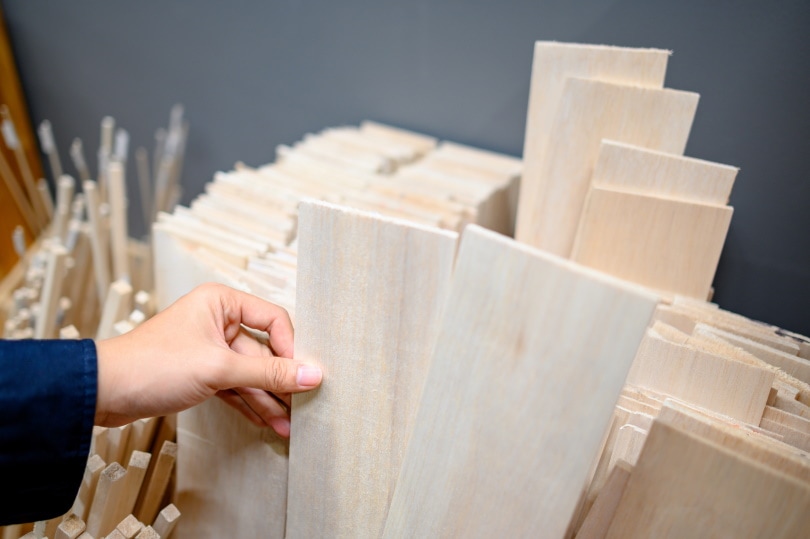
Conclusion
Picnic tables are lots of fun, especially if you live in one of the warmer states and love having friends and family members over for impromptu dining. Now, unless you want the table to rot, decay, and break before long, you need to pay extra attention to the material. Today, we checked out seven tried-and-true wood types that work best for picnic benches. They’re all different, however, and have their pros and cons.
So, before you commit to anything, take a moment to familiarize yourself with our detailed reviews. There, you’ll find all the necessary info on the cost, weight, durability, and weather resistance. Want to learn more about wood? Then check out our other in-depth guides on wood types, DIY projects, and more!
Featured Image Credit: Rob Hyrons, Shutterstock
Contents

 The 7 Best Types of Wood for Picnic Tables
The 7 Best Types of Wood for Picnic Tables